Abstract
With the gradual increase in the proportion of new energy sources in the power grid, there is an urgent need for more flexible resources to participate in short-term regulation. The impact of communication network channel quality will continue to magnify, and factors such as communication latency may directly affect the efficiency and effectiveness of resource regulation. In this context of a large number of flexible demand-side resources accessing the grid, this article proposes a bidirectional channel delay measurement method based on MQTT (Message Queuing Telemetry Transport). It can effectively evaluate the real-time performance of communication links, considering that resources mainly access the grid through the public network. Subsequently, focusing on two typical types of resources on the demand side, namely, split air conditioners and central air conditioners, this article proposes an assessment method for correcting the response capabilities of air conditioning resources considering communication latency. Experimental simulations are conducted, and the results demonstrate that under given communication conditions, this method can more accurately estimate the response capability of air conditioners. This provides a basis for formulating more reasonable scheduling strategies, avoiding excessive or insufficient resource regulation caused by communication issues, and aiding the power grid in achieving precise scheduling.
1. Introduction
1.1. Background
In the context of the profound transformation of the current energy structure and the flourishing development of smart grids, flexible demand-side resources such as distributed energy, smart homes, and electric vehicle charging stations are gradually becoming an indispensable part of the power system due to their characteristics of flexible deployment, environmental friendliness, and proximity to consumer terminals [1,2]. In contrast to the past reliance on dedicated network connections for large-scale power plants and centralized loads, these emerging distributed resources tend to interact with the power grid through public communication networks [3,4,5]. This shift has greatly promoted the universal accessibility and utilization efficiency of resources, but it has also introduced new challenges, especially considering the openness, dynamic changes, and channel instability of such network environments [6,7,8], which are more prominent against the backdrop of the continuous increase in the penetration rate of new energy sources. With the increasing share of wind and solar energy in the power grid, there is a need for frequent and precise scheduling of a larger number of small-scale resources scattered across different locations to effectively respond to supply and demand fluctuations within short periods [9,10,11]. In this scenario, the performance of the communication channels, particularly the issue of latency, has become a major constraint determining scheduling efficiency and system stability [12,13]. Latency not only affects the transmission and execution of control commands, reducing the timeliness of adjustments, but also increases the complexity and uncertainty of system control, impacting the dynamic balance of the power grid and the quality of electrical energy. Therefore, the evaluation of communication link performance, especially the measurement of communication latency, has become a core issue in current research and technological innovation.
1.2. Literature Review
Information communication plays a crucial role in energy management. For instance, through Grid-to-Vehicle (G2V) and Vehicle-to-Grid (V2G) protocols, communication systems can facilitate data exchange, making the interaction between electric vehicles and the grid more intelligent. Additionally, communication technology is equally important in photovoltaic (PV) systems and energy storage (ES). It can monitor and control the generation, storage, and distribution of energy in real time, ensuring maximum energy utilization and grid stability [14]. However, to achieve these goals, the measurement and management of communication latency are essential. Communication latency directly affects the timeliness of data transmission and the responsiveness of the system.
The most commonly used methods for measuring network latency are based on the Internet Control Message Protocol (ICMP), such as the ping method [15] and the traceroute method, the latter of which primarily functions to test the routing information from the source to the destination. NetPerf [16] is also a common network measurement tool based on the Transmission Control Protocol (TCP) and User Datagram Protocol (UDP). sFlow [17], developed through collaboration among InMon, HP, and FoundryNetworks, is a representative example of sampled measurement technology that requires embedding in hardware devices. NetFlow measurement technology [18,19], developed by Cisco, uses flow-switching technology and is mainly utilized in Cisco’s own routing and switching devices. TCPProbe introduces a network performance measurement tool based on optimized probing methods, utilizing legitimate TCP datagrams as probe messages [20]. Meanwhile, one study in the literature [21] uses the Precision Time Protocol (PTP) for measuring message latency, estimating it as the delay of user data. Traditional one-way delay measurement based on PTP is proposed in the literature [22], where the delay of the network path is calculated by measuring the round-trip delay of the link. Active measurement-based precise parallel flow monitoring methods are presented in the literature [23]; these methods aggregate measurement samples of other flows into the same flow sample, utilizing clustering algorithms from machine learning to improve measurement accuracy. A theoretical model of the transfer function for power line communication channels based on transfer parameters is discussed in the literature [24], considering the impact of electric appliances on the channel’s transfer function. Additionally, a segmented delay measurement method for Wide-Area Measurement Systems (WAMS) is proposed in the literature [25], effectively measuring the delays at various stages of the WAMS data transmission process, providing an analytical basis for ensuring the real-time currency and accuracy of WAMS data. The network latency measurement methods proposed in the abovementioned domestic and international literature primarily rely on controllable communication network environments. In uncontrollable environments such as the public Internet, the direct application of these methods may be limited. As flexible-resource access mainly occurs through open public communication networks, there is a higher demand for precise measurement of network latency. Therefore, there is an urgent need to propose solutions to the problem of uncontrollable network latency when facing a large number of flexible demand-side resources accessing the network [26,27].
In addition, currently, flexible resources mainly participate in various flexibility markets through demand-side management. With technological advancements and policy support, more and more businesses and household users will have the opportunity to actively participate in these markets through smart devices and energy management systems [28,29]. A study in the literature [30] discusses a demand-side management strategy aimed at minimizing the daily peak power of electric vehicle charging stations. Another study [31] proposes an energy optimization strategy for micro-grids that accounts for demand-side management, achieving reliable and economical operation of micro-grids. A study [32] establishes a bi-level optimization model for the aggregation of demand-side resources participating in peak shaving, providing effective guidance for retail market entities to develop strategies for participating in peak-shaving auxiliary services. Finally, one study [33] proposes a robust clearing model and pricing method for capacity markets considering flexible adjustment demand, which helps flexible resources to provide capacity to meet the system’s flexible adjustment needs. These are the basis for the participation of flexible demand-side resources in regulation.
When flexible resources participate in short-term regulation services, the response capability of resources will exhibit significant value degradation due to latency. By studying the evaluation method of distributed resources’ response capability, it is possible to scientifically quantify the adjustment ability and contribution of various types of distributed resources at different time scales. This provides strong support for formulating reasonable resource planning schemes and improving the efficiency and stability of the power system [34,35,36]. One article in the literature [37] proposes an evaluation method for the response capability of household electric heating load based on temperature forecasts and a load cluster control strategy. Another article [38] presents a framework for evaluating the response capability and interaction of air conditioning temperature control loads participating in distributed photovoltaic integration in the electricity market environment, based on data-driven and deep belief networks. One published study [39] constructs a two-stage adjustable capacity evaluation model for electric vehicles for peak-shaving and valley-filling auxiliary services from a physical and economic perspective. Another study [40] proposes an analysis and evaluation method for assessing the response capability of industrial loads supporting the operation of isolated industrial park networks. A different study [41] analyzes the participation and characteristics of industrial loads in primary frequency regulation as a specific type of adjustable load. One article [42] established an aggregated response capability evaluation model that includes response time and duration, which is used to assess the overall response capability of aggregated resources in a virtual power plant. Another article [43] designs a potential assessment method for response based on user response characteristics under differentiated subsidy prices and establishes a user ranking sequence based on response potential. Finally, one study in the literature [44] presents an adjustable capacity evaluation method based on multi-objective optimization, establishing an aggregate model considering demand response and economic constraints to demonstrate the adjustable capacity of integrated energy systems. The abovementioned literature mainly focuses on the application scenarios and technical means to study the response capability of resources, with less consideration given to the impact of communication factors, especially latency, in the assessment of response capability. As more flexible resources participate in smaller-scale regulation, the response capability of resources needs to be recalculated after considering the actual communication network environment in order to more accurately reflect the availability of resources and ensure the reliability of decision making.
1.3. Innovations and Contributions
- In the context of large-scale flexible-resource integration scenarios, a method for efficient communication-network delay measurement based on the MQTT protocol is proposed to address potential challenges faced by traditional communication architectures. The MQTT protocol, known for its lightweight nature, low bandwidth consumption, and Quality of Service (QoS) guarantee mechanism, is suitable for reliable communication in resource-constrained environments and unstable network conditions. It provides a solid foundation for precise delay measurement in demand-side resource integration.
- By collecting a large quantity of network latency data through practical deployment and testing, then further analyzing and transforming it, the data are quantified as a high-latency rate indicator to accurately reflect the impact of network conditions on the transmission of resource scheduling commands. Building upon this foundation, the article delves into how to incorporate latency factors into the evaluation model of flexible resources, especially air conditioning response capabilities. By introducing latency constraints, an innovative method for assessing resource response capabilities considering network latency is proposed. This method can more accurately predict and evaluate the actual adjustment capabilities of flexible resources such as air conditioning when facing rapidly changing energy demands.
1.4. Structure
The subsequent sections of this paper are structured as follows. Section 2 introduces the method of bidirectional channel latency measurement based on MQTT. Section 3 proposes an air conditioning response capability evaluation method considering latency. In the fourth part, the proposed methods are tested through case studies. Finally, in Section 5, the article provides a summary.
2. A Method for Measuring Bidirectional Channel Delay Based on MQTT
Due to the diverse types of data sources, numerous participating users, novel application functionalities, and high future scalability requirements involved in an aggregated control network for flexible resources, its overall architecture often adopts a layered design approach. Through system layering, different layers’ functionalities address corresponding issues at each level. As shown in Figure 1, the typical architecture of an aggregated control network for flexible resources is illustrated.
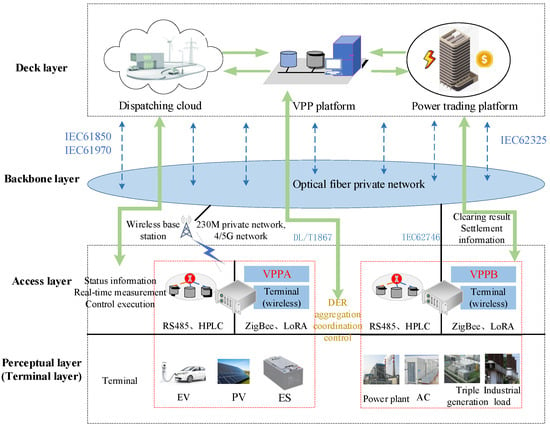
Figure 1.
A flexible-resource aggregation control network.
The four-layer architecture of a flexible-resource aggregation and control network, including the perception layer, access layer, backbone layer, and platform layer, aligns with the architecture of the Internet of Things (IoT), which consists of cloud, management, edge, and end devices. This indicates that the flexible-resource aggregation and control network is a typical IoT architecture.
In terms of delay measurement for the control network, it is typically divided into two modes: out-of-band measurement and in-band measurement. Out-of-band measurement technology simulates business data packets indirectly and periodically sends packets to measure and analyze the end-to-end performance of the network path. In contrast, in-band measurement technology marks real business data packets to measure and analyze the performance of actual business flows [45,46,47]. The mainstream communication protocols for resource aggregation and control have significant differences in packet formats. If in-band measurement is adopted, the protocol needs to be modified according to the measurement requirements. However, due to the large number of third-party assets in the massive flexible resources and considering cost and security, it is not feasible to achieve large-scale protocol modifications. Therefore, out-of-band measurement methods can be employed for large-scale delay measurement of flexible resources. An out-of-band measurement system can generally be designed as a two-layer structure, consisting of measurement probes and a master measurement station.
- Measurement Probes: These are primarily responsible for capturing data on key network links. They are deployed on various critical links within the network and typically function as complete network measurement devices with measurement and communication capabilities. Each probe is equipped with a local database for temporary storage of captured data packets and for timely uploading based on the settings of the master measurement station. It also ensures that test data are not lost in case of network congestion.
- Master Measurement Station: This serves as the core component of the measurement system and has two main functions: node management and data analysis. It typically employs server clusters and large databases. The master measurement station manages all the collection nodes and controls the invocation, configuration, status monitoring, and upgrades of the measurement probes. It can issue user commands and measurement parameter requirements to the measurement probes.
A flexible-resource aggregation and control network that accesses the public network is classified as a typical uncontrolled network. The deployment range of measurement probes is relatively limited. Due to cost and security considerations regarding the deployment of measurement probes, they can be deployed within controlled aggregation control units. They can be extended to perform the functions of the master measurement station within the edge state perception system of the cloud network. This forms the out-of-band measurement architecture as shown in Figure 2.
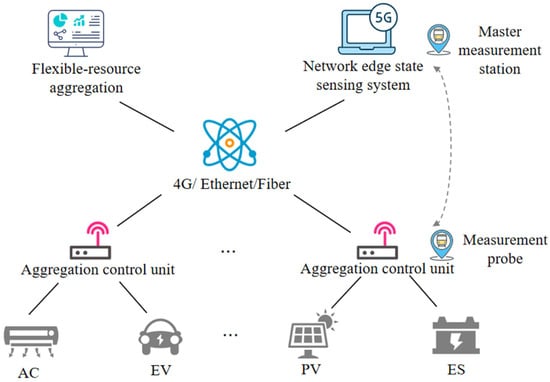
Figure 2.
Out-of-band measurement in a flexible-resource aggregation control network.
In the selection of an out-of-band measurement protocol, one needs to consider the characteristics of the flexible-resource aggregation and control network. MQTT is a “lightweight” communication protocol based on the publish/subscribe pattern, and it is built on top of TCP/IP (Internet Protocol). Similar protocols include TCP, UDP, and HTTP (Hypertext Transfer Protocol). Table 1 shows a comparison of the four protocols in terms of lightweightness, reliability, secure communication, bidirectional communication, continuous connection, stateful sessions, and support for large-scale IoT.

Table 1.
Comparison of the four protocols.
From the table, it can be seen that MQTT possesses characteristics and functionalities specific to the requirements of the Internet of Things. Therefore, for the out-of-band network measurement needs of a flexible-resource aggregation and control network, using this protocol provides significant advantages. Additionally, in contrast to other common IoT protocols such as Constrained Application Protocol (CoAP), CoAP uses UDP/IP, which makes it more efficient when running on resource-constrained devices but sacrifices a certain degree of reliability. Resource-management business systems mostly use TCP to transmit data; therefore, using MQTT for measurement is more aligned with the latency of real business systems. CoAP adopts a request/response model, which is a more traditional client–server interaction pattern. In our measured business system, a platform connects multiple edge devices, and using the publish/subscribe model in MQTT can improve measurement efficiency. On the other hand, Advanced Message Queuing Protocol (AMQP), as a more general and complex message queue protocol, provides more advanced features, which may increase system complexity and resource consumption.
Consequently, for the latency measurement requirements of a flexible-resource aggregation and control network, the MQTT approach was selected for the data interaction between the flexible resources and the master station. Meanwhile, the system on the main site includes a data validation module that provides prompts and corrections for format errors and abnormal values in the data. The data interaction architecture is shown in Figure 3.
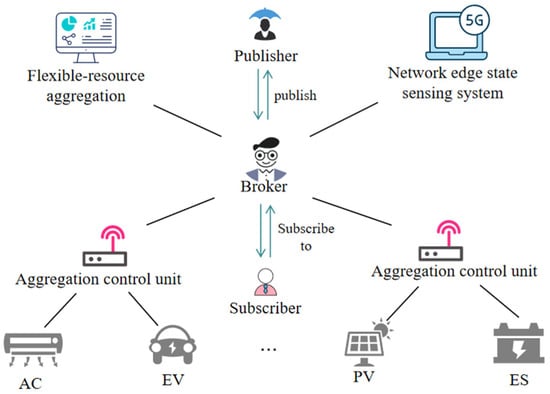
Figure 3.
Data interaction architecture based on MQTT.
The MQTT protocol only implements the format for message transmission and does not restrict the user protocol to follow a specific style. Therefore, on top of the MQTT protocol, it is necessary to define our own communication protocol. Since any supported type can be represented using JSON, such as strings, numbers, objects, arrays, etc., the syntax rules are as follows: objects represent key–value pairs, data are separated by commas, objects are enclosed in curly braces, and arrays are enclosed in square brackets. The JSON hierarchical structure is concise and clear, making it easy to read and write, facilitating machine parsing and generation, and effectively improving network transmission efficiency. Therefore, the combination of MQTT and JSON is the optimal solution. After setting up an MQTT broker server on the platform server, bidirectional channel latency measurement is conducted using the process depicted in Figure 4.
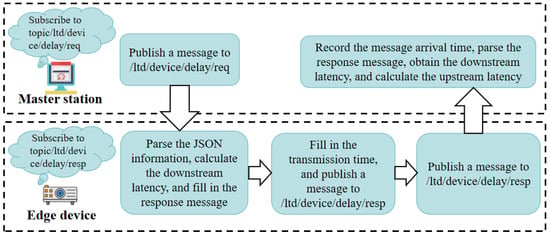
Figure 4.
Bidirectional channel latency measurement scheme based on MQTT.
Taking a measurement task as an example, the master station initiates a latency measurement task, assembles the request message, and timestamps it as t1. The message is then pushed to the agreed topic delay_req on the message broker service (hereinafter referred to as broker). Each terminal consumes messages from the topic delay_req, records the message arrival time (t2), and calculates the downstream communication latency of the message as delayDown = t2 − t1. Subsequently, each terminal sends a response message to the topic delay_resp, carrying delayDown and the sending time (t3) data. The master station consumes the upstream message from the topic delay_resp, records the arrival time (t4), parses the message to obtain delayDown and t3, and calculates the upstream latency as delayUp = t4 − t3. The master station program writes the measured values of the upstream and downstream latency, delayUp/delayDown, into the database, completing this round of the latency measurement task. After waiting for a measurement cycle, the next measurement task is executed. If the edge device experiences a disconnection, the main site will not receive the response message, resulting in an infinite delay.
The request message initiated by the master station for calculating the delay is shown in Table 2.

Table 2.
Request message for calculating the delay.
After receiving the request message, the terminal responds with a message as shown in Table 3.

Table 3.
Response message.
The field definitions are as shown in Table 4.

Table 4.
Field definitions.
3. Evaluation Method for the Tunable Potential of Split Air Conditioning Groups Considering Delay
From the perspective of response, devices may fail to participate in a certain regulation due to certain uncertain factors, among which communication delay is one of the factors that need to be considered. Defining a delay higher than a certain set value as high latency, in this case, user refusal to respond constitutes a response failure. In response to this situation, it is necessary to assess the reliability of device response.
3.1. Response Reliability Evaluation
The measured delay data are introduced into the assessment of resource response capability in the form of a metric called high-latency rate. The high-latency rate represents the probability of control failure due to high latency in the communication link of response devices (such as air conditioners, energy storage systems, electric vehicle charging stations, etc.). It is defined as the ratio of the duration of high latency to the total measurement time within a certain period. The ratio of the duration of high latency, , is expressed as follows:
where represents the duration of delay collection for the i-th device, represents the duration of high latency for the i-th device, and I represents the total number of devices.
Uncertainty factors are represented using a response degree indicator, where response degree refers to the ratio of a device’s response capacity to its controllable capacity. The degree of responsiveness is expressed as follows:
where is the response capacity of the device and is the controllable capacity of the device.
As shown in Figure 5, (a) represents the user’s original equivalent load curve, while (b) represents the user’s equivalent load curve considering the delay factor.

Figure 5.
Equivalent load curves before and after considering the delay.
Based on historical data within a certain period, the user’s equivalent load curve Ψ(P) can be obtained, where the horizontal axis represents the user’s load power and the vertical axis represents the duration of the load. T denotes the time period, and any point on the curve indicates that the duration for which the user’s load is greater than or equal to P is t, with Pmax representing the maximum value of the user’s load. The response capability of a certain device is denoted as ΔP. When the device is in a state of high latency, the user’s equivalent load curve can be represented as Ψ(P − ΔP), which is equivalent to shifting the continuous load curve to the right by ΔP of load.
If the high-latency rate of this device is denoted as , then the continuous load curve of the user will become in the figure; its calculation formula is as follows.
Based on the above equation, the variation of the user’s continuous load curve under different values can be obtained, as shown in Figure 6.
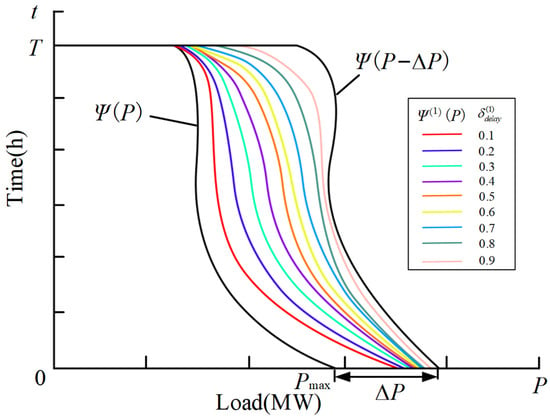
Figure 6.
User load curves under different high-latency rates.
In Figure 5b, represents the area enclosed by the initial user equivalent load curve and the equivalent load curve considering the high latency rate of this device. Its physical meaning is the reduction in the response capacity of the user’s load due to high latency. The calculation formula is as follows.
The total responsive capacity of the user’s device is Sall:
This can be used to calculate the corrected actual responsive capacity value Sreal for the user.
Assuming the user’s responsiveness under a certain stimulus is , according to the corrected actual responsive capacity value, the trustworthy response level of the user considering the delay impact is obtained as shown in the following equation.
Based on the above reliability assessment of response, tailored resource response capability correction models for split air conditioning and central air conditioning, two typical adjustable resources, are proposed, and their trustworthy response capabilities are calculated. The Response reliability evaluation algorithm is shown in Algorithm 1.
| Algorithm 1 Response reliability evaluation |
| Input: , , , |
| Initialization: , I, T, |
| Procedure: |
| Calculate of I devices with and according to (1) |
| Determine equivalent load curve with and according to (3) |
| Access reduction in responsiveness with according to (4) |
| Calculate total responsive capacity according to (5) |
| Adjust actual responsive capacity value with and according to (6) |
| Fixed the degree of trusted response with , and according to (7) |
| Results: |
3.2. Adjustment of Air Conditioning Response Capability
For the modeling of split air conditioning (AC), refer to the method proposed in [48]. The physical model input parameters for participation in response include the control signal, outdoor temperature, indoor temperature setpoint, and indoor temperature at time t, with the outputs being the air conditioning power and the indoor temperature for the next time period. In addition, the model should consider the air conditioning unit’s own parameters and the parameters of the building volume. For ease of calculation, these parameters are set as constants based on statistical results. The architecture of the split air conditioning load model is shown in Figure 7.
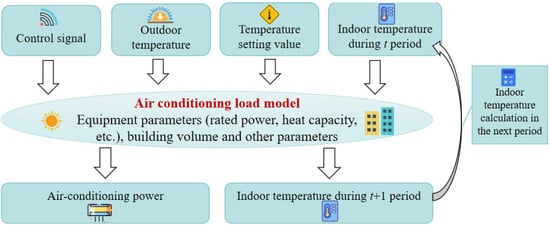
Figure 7.
Split air conditioning load model architecture diagram.
The actual power of the air conditioning unit at time t is calculated by the following equation:
where is the rated power of the air conditioning unit; is the operational status of the air conditioning unit, with 1 indicating “on” and 0 indicating “off”; represents the minimum indoor set temperature; and represents the maximum indoor set temperature. indicates the air conditioner’s working state at time t + 1. The indoor temperature for the next time period t + 1, , can be calculated using the following equation.
where represents the indoor temperature at time t; is the indoor–outdoor heat exchange value; represents the indoor temperature coefficient, indicating the heat required for every 10 °C increase in indoor temperature; represents the air conditioning heat capacity; and represents the time interval. After linearization, the following equation is shown.
The response capability of air conditioning equipment, , is expressed as follows:
The minimum adjustable physical capacity, , is expressed as follows:
Taking into account the user’s trusted response level, one can calculate the air conditioner’s trusted response capability, .
According to the calculation methods proposed in [49,50], the calculation results of the confidence interval for the adjustment capability, [, ], are as follows:
where represents the most trusted adjustment capacity, represents the upper limit of trusted response capability, represents the lower limit of trusted response capability, and Z is the critical value related to the confidence level.
For the central air conditioning (CAC), assuming that the central air conditioning system in the building operates in cooling mode during the summer, one operational cycle includes the cooling and shutdown periods. During the cooling period, the chiller unit processes the chilled water to provide cooling, and the chilled water absorbs indoor heat through the evaporator coils, thereby reducing the indoor temperature. During the shutdown period, the chiller unit ceases operation, and the indoor temperature generally shows an increasing trend.
The change in indoor heat can be obtained by the difference between the heat entering the indoor environment over a period of time and the heat reduced by the central air conditioning load. Based on this principle, the time-varying curve of the building’s indoor temperature can be derived for the central air conditioning system, as shown in the following equation:
where represents the indoor temperature of the central air conditioning system at time t, represents the indoor temperature of the central air conditioning system at time t during the cooling period, represents the initial indoor temperature of the period, represents the indoor temperature of the central air conditioning system at time t during the shutdown period, represents the initial indoor temperature of the period, represents the rated cooling capacity of the central air conditioning system, and represents the temperature change parameter of the chilled water. The parameters , , , and are determined by the building parameters, as shown in the following equations:
where and represent the air density and the specific heat capacity of air, respectively; represents the indoor volume; represents the heat storage coefficient of the interior walls; represents the interior wall area; and represent the heat conduction coefficients of the house roof and walls, respectively; represents the roof area; represents the wall area; represents the total heat dissipation load from interior equipment, lighting, and personnel; represents the outdoor temperature; represents the mass of chilled water; represents the specific heat capacity of chilled water; and represent the inlet and outlet water temperatures of the chilled water; and is set to 1.8.
Based on Equation (18), a schematic diagram of indoor temperature variation is shown in Figure 8, with the indoor temperature set at ; the range of indoor temperature variation is in the range [, ].
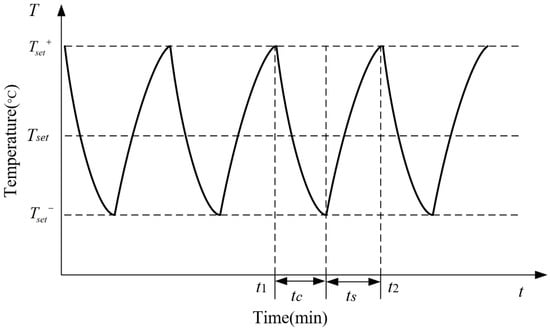
Figure 8.
Temperature change curve of room with central air conditioning.
The corresponding operating power of the central air conditioning system is shown in Figure 9, with the operating power switching between the rated power and zero. The durations for which the central air conditioning system is in the cooling and shutdown states are denoted as tc and ts, respectively.
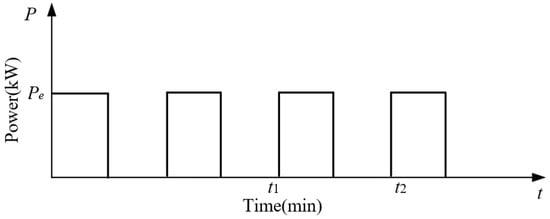
Figure 9.
Operating status and power of central air conditioning.
One can calculate the average cooling power of the central air conditioning system over one cycle based on the above figure.
From this, the credible response capability of the central air conditioning system is expressed.
The confidence interval for the regulatory capacity is [,].
where represents the most credible response capability of the central air conditioning system, represents the upper limit of the credible response capability of the central air conditioning system, and represents the lower limit of the credible response capability of the central air conditioning system.
The following takes split air conditioning as an example and gives the pseudo-code of the algorithm as shown in Algorithms 2 and 3.
| Algorithm 2 Split air conditioning power |
| Input: |
| Initialization: |
| Procedure: |
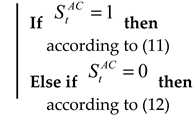 |
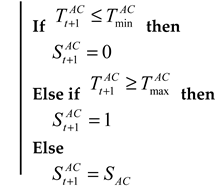 |
| Calculate the air conditioning actual power according to (8) |
| Results: |
| Algorithm 3 Responsiveness correction |
| Input: , Z |
| Procedure: |
| Update responsiveness with according to (13) |
| with according to (14) |
| Computes trusted response capability with according to (15) |
| Confidence interval of adjusted ability [,] with Z according to (16) and (17) |
| Results: |
4. Example Analysis
4.1. Fixed Responsiveness of Resident Users
Taking residential users as an example, according to the method proposed in this paper, the calculation flowchart of the trusted response capability for these users is provided, as shown in Figure 10.
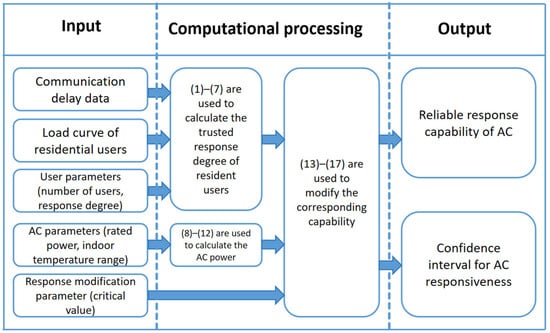
Figure 10.
Calculation flowchart for trusted response capability of residential users.
In the given residential area, there are a total of 2285 households and 10,000 split air conditioners. The rated power of a single air conditioner follows a random distribution within the interval [1.6 kW, 2 kW]. The minimum indoor temperature setpoint is 24 °C, and the maximum is 26 °C. All air conditioners are operating stably within the set temperature range before responding. The time interval is set to 1 h.
The calculated power values of the air conditioner group in the residential area at different outdoor temperatures are shown in Table 5.

Table 5.
Aggregate power of air conditioners at different outdoor temperatures.
As can be seen from the above table, when the outdoor temperature is 32 °C, the aggregate power of the air conditioner is the maximum, and the aggregate power is the minimum at 28 °C. The aggregate power of the air conditioner load increases with the increase of the outdoor temperature. This is because when the outdoor temperature is high, the indoor–outdoor temperature difference is large, and the outdoor heat is transferred into the room at a faster rate. The aggregate power of air conditioners at different set temperature ranges and different outdoor temperatures is calculated below, as shown in Table 6.

Table 6.
Aggregate power of air conditioners with different set temperature ranges and different outdoor temperatures.
It can be seen from the above table that when the difference between the outdoor temperature and the set temperature of the air conditioner is the same, the aggregate power of the air conditioner is the same.
The load aggregation power of a typical daytime split air conditioner group in summer in a set temperature range of [24 °C, 26 °C] is calculated, as shown in Figure 11.
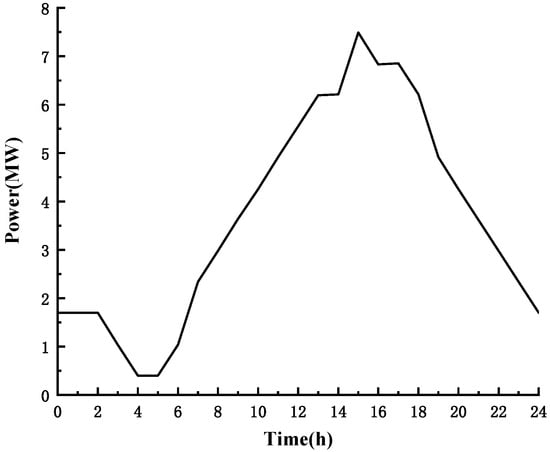
Figure 11.
Air conditioning load power.
As shown in the figure above, the trend of the power load of the air conditioner group is basically the same as the trend of the outdoor temperature. When the temperature rises during the day, the frequency of air conditioner use increases, leading to a significant rise in power. When the temperature drops at night, the power also decreases accordingly. Although the power of a single air conditioner load is limited, considering the aggregation of air conditioner loads, the overall response capability of the residential area is relatively large.
By sorting the load of a household user in the residential area based on historical data, the original responsive load curve of the user without considering delay is obtained, as shown in Figure 12. It represents the total load of the household, with the response probability indicating the success rate of the response. The horizontal axis represents the user load, and the vertical axis represents the response probability.
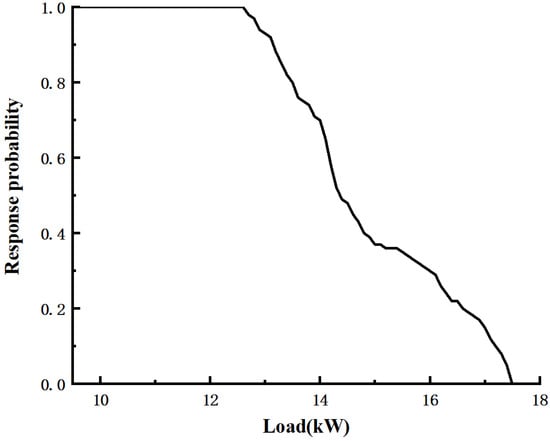
Figure 12.
Residential users can respond to load curves.
The responsive load of a certain split air conditioner for this user is 2.5 kW. When this split air conditioner experiences high latency, it is equivalent to the device having a response capability of 0 and thus being unable to participate in the current response. The user’s responsive load curve at this time is shown in Figure 13.
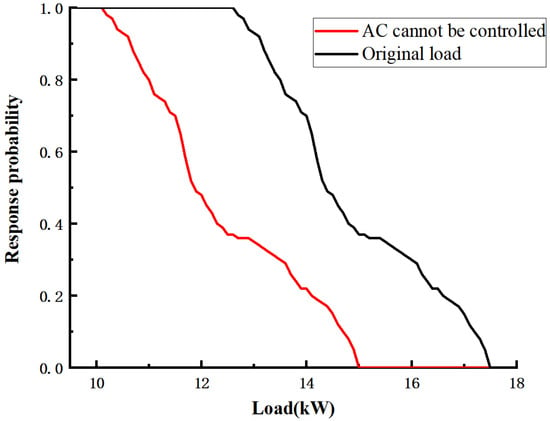
Figure 13.
User response load curve considering delay.
Considering the impact of high latency on the demand response capability of air conditioners, the continuous load curves of this split air conditioner under different high-latency rates can be obtained. At this time, the user’s response level under a certain incentive is 0.35. Based on this, the trusted response levels of the user under different high-latency rates are calculated, as shown in Table 7.

Table 7.
Consider the degree to which users can be trusted to respond with high latency.
From Table 7, it can be seen that with the increase in high-latency rates, the degree of user trusted response significantly decreases. When the high-latency rate is low (0.1–0.3), even a small delay can have a noticeable impact on response capability. At a high-latency rate of around 0.5, the trusted response degree begins to decline rapidly, which can be considered a critical point. Beyond this critical point, the response capability deteriorates sharply, and other regulatory measures need to be considered as a supplement. When latency rates are high (0.7–0.9), the trusted response degree drops to an extremely low value, making it almost impossible to provide effective load response.
In this residential area, the high-latency rates of split air conditioners for 2285 households are distributed within the range of (0–1). With a confidence level of 95%, the Z is 1.645 [42,43]. The trusted adjustable potential for participating in the response over a 12-h period is calculated, and the results are shown in Table 8.

Table 8.
Residential user credible response potential.
As shown in the table above, at 12:00, the total responsive power for this residential area is 3754.074 kW, with the responsive capability of the split air conditioner group being 3304.169 kW. The confidence interval provides statistical confidence in the trusted response potential. The 95% confidence interval is [3270.087, 4238.061], indicating that in 95% of cases, the response capability will fluctuate within this range.
The response degree reflects the enthusiasm of residential users to participate in load adjustment at various times. It can be seen that from 3:00 to 5:00, the response potential is almost zero, which is related to the daily routines of residential users. The response potential gradually increases during the morning period as devices begin to be used gradually. From 10:00 to 12:00, residential electricity consumption is relatively high, and the potential for load adjustment is also at its maximum. During this time, residential users are most likely to participate in load adjustment.
Based on the calculated trusted response capability and confidence interval, these figures can provide a basis for quickly mobilizing the load of residential users in emergency situations. This helps in setting more reliable response targets in emergency plans and improves the scientific accuracy and market competitiveness of trading decisions in the electricity market.
4.2. Discussions
The research outcomes presented in this paper are not confined solely to the application scope of air conditioning systems. This set of solutions can be widely applied to the management of diverse flexible energy resources, such as distributed photovoltaics, energy storage systems, and electric vehicle charging networks. For other types of flexible demand resources, it is only necessary to adjust the corresponding models and parameter settings according to their specific characteristics and operating modes. In addition, depending on the layered architecture, with the increase in the number of intelligent devices, the system is scalable. To avoid affecting the computing speed, the data processing capacity can be allocated to the edge through edge computing, effectively reducing the burden on the central server. This paper primarily focuses on the impact of delay as an uncertain communication factor, while current research on communication uncertainty may rely more on mathematical models [51,52]. In contrast, this paper utilizes actual measured data, which can more accurately reflect the delay conditions in real environments. We also recognize the necessity to introduce more uncertainty factors, such as user response willingness mentioned in [53,54], to enhance the applicability and robustness of the model.
5. Conclusions
The core of this study lies in addressing the response latency issues encountered when integrating demand-side flexible resources into the energy management system. The article innovatively proposes a bidirectional communication latency measurement technique based on the MQTT protocol, which accurately measures and analyzes network latency characteristics. This not only strengthens the system’s real-time perception of network conditions but also provides a scientific basis for optimizing communication processes and reducing unnecessary data delays, as well as offering real-time data support for subsequent resource regulation strategies. Furthermore, a resource responsiveness adjustment model considering network delay is proposed. The highlight of this model is the creative inclusion of latency reliability assessment indicators, enabling accurate prediction and evaluation of the actual response of air conditioning systems even in the presence of communication delays. This effectively mitigates the negative effects of latency, ensuring timely execution of control commands. This undoubtedly provides a guarantee for enhancing the efficiency of flexible resource utilization and the precision of regulation.
This paper assumes that high latency uniformly affects all devices. In the future, we will explore the impact of factors such as device type and location on delay.
Author Contributions
Conceptualization, Y.L. and C.L.; methodology, Y.L. and C.L.; software, Y.L. and J.T.; validation, J.T. and S.L.; formal analysis, S.L.; investigation, X.W.; resources, J.T.; data curation, C.L.; writing—original draft preparation, Y.L. and C.L.; writing—review and editing, J.T. and S.L.; visualization, X.Z. and X.W.; supervision, Y.L.; project administration, C.L. All authors have read and agreed to the published version of the manuscript.
Funding
This work was supported by the National Key R&D Program of China (No. 2021YFB2401200).
Data Availability Statement
The data presented in this study are available on request from the corresponding author. The data are not publicly available due to privacy.
Conflicts of Interest
Authors Ying Liu, Chuan Liu, Jing Tao, Shidong Liu, Xiangqun Wang and Xi Zhang were employed by the company State Grid Smart Grid Research Institute Co., Ltd. The remaining authors declare that the research was conducted in the absence of any commercial or financial relationships that could be construed as a potential conflict of interest.
References
- Zhang, S.; Chen, Y.; Shao, X.; Zhang, J.; Chen, X.; Tang, W. Multi-objective Day-ahead Optimization Dispatch of Distribution Network Side Flexible Resources Based on Fine Evaluation of Residential User Regulation Ability. Electr. Power Supply Util. 2022, 39, 42–50. [Google Scholar]
- Xue, C.; Ren, J.; Ma, X.; Cui, W.; Liu, Y.; Wang, X. Mechanism and Practice of Northwest Peak-shifting Ancillary Service Market Oriented to High Proportion of New Energy Integration. China Electr. Power 2021, 54, 19–28. [Google Scholar]
- Hong, H.; Leng, A.; He, J.; He, X.; Liang, C.; Luo, D. Research on Network Segment Delay Measurement Technology of Smart Low-voltage Power Grid. Mod. Electron. Tech. 2020, 43, 179–182+186. [Google Scholar]
- Wang, G.; Song, Y.; Guan, L.; Zhang, H.; Gao, K.; Ding, H.; Wang, Z.; Zheng, Q.; Zhao, J. Architecture and Evolution Path of Secure Interactive Communication Network for Distributed Source-Load-Storage Resources. Electr. Power Inf. Commun. Technol. 2023, 21, 10–18. [Google Scholar]
- Cao, C.; Xie, J.; Yue, D.; Huang, C.; Wang, J.; Xu, S.; Chen, X. Distributed Economic Dispatch of Virtual Power Plant under a Non-Ideal Communication Network. Energies 2017, 10, 235. [Google Scholar] [CrossRef]
- Zhang, H.; Li, J.; Wu, Q.; Wu, S.; Zhu, S.; Zhang, T. Communication Network System Architecture and Communication Mode Adaptation Method for Virtual Power Plant. Electr. Power Inf. Commun. Technol. 2022, 20, 47–54. [Google Scholar]
- Wang, G.; Su, J.; Pan, J.; Zhang, H.; Gao, K.; Liu, C. Prospects for Research on Communication Network Architecture and Key Technologies of Virtual Power Plant. Autom. Electr. Power Syst. 2022, 46, 15–25. [Google Scholar]
- Yin, S.; Jin, M.; Chen, X.; Guo, X.; Feng, J. Modeling and simulation of optimal configuration of virtual power plant oriented to power Internet of Things. In Proceedings of the IEEE 4th International Conference on Automation, Electronics and Electrical Engineering, Shenyang, China, 19–21 November 2021; pp. 751–754. [Google Scholar]
- Chen, Q.; Wang, W.; Wang, H. Coordinated Optimization of Active Distribution Network with Multiple Microgrids Considering Demand Response and Hybrid Game. Autom. Electr. Power Syst. 2023, 47, 99–109. [Google Scholar]
- Sheng, H.; Wang, C.; Li, B.; Liang, J.; Yang, M.; Dong, Y. Multi-timescale active distribution network scheduling considering demand response and user comprehensive satisfaction. IEEE Trans. Ind. Appl. 2021, 57, 1995–2005. [Google Scholar] [CrossRef]
- An, X.; Wang, L.; Hu, X.; Zhang, Y.; Wang, Z. Collaborative regulation control optimization on demand side of microgrid based on multiagent. In Proceedings of the 2019 4th International Conference on Intelligent Green Building and Smart Grid (IGBSG), Yichang, China, 6–9 September 2019; IEEE: Piscataway, NJ, USA, 2019; pp. 493–496. [Google Scholar]
- Yu, Y.; Sun, H.; Fang, Z.; Wang, W.; Ding, J.J.; Gao, B. Research on optimization of 5G communication slice access with time-delay requirement constraints for protection communication in distribution network. Electr. Power Supply Util. 2021, 38, 29–34. [Google Scholar] [CrossRef]
- Qian, C.; Xu, X.; Mei, J.; Yu, J.; Zheng, J.Y.; Wang, Y.; Ji, W.L.; Zhang, M. Clock synchronization compensation algorithm for terminal queue time delay asymmetric communication path with IEEE 1588 applied in distribution network. Power Syst. Technol. 2015, 39, 3622–3626. [Google Scholar]
- Rubino, L.; Rubino, G.; Esempio, R. Linear Programming-Based Power Management for a Multi-Feeder Ultra-Fast DC Charging Station. Energies 2023, 16, 1213. [Google Scholar] [CrossRef]
- Luckie, M. Scamper: A scalable and extensible packet prober for active measurement of the internet. In Proceedings of the ACM Sigcomm Conference on Internet Measurement, Melbourne Australia, 1–30 November 2010; Association for Computing Machinery: New York, NY, USA, 2010; pp. 239–245. [Google Scholar]
- Wang, X. Research on Link Delay Measurement and Flow Table Management Methods for SDN Data Center Network. Doctoral Dissertation, University of Electronic Science and Technology of China, Chengdu, China, 2018. [Google Scholar]
- Afaq, M.; Song, W.C. sFlow-based Resource Utilization Monitoring in Clouds. In Proceedings of the 18th Asia-Pacific Network Operations and Management Symposium (APNOMS), Kanazawa, Japan, 5–7 October 2016; IEEE: Piscataway, NJ, USA, 2016; pp. 1–3. [Google Scholar]
- Liu, X.; Tang, Z.; Yang, B. Predicting Network Attacks with CNN by Constructing Images from NetFlow Data. In Proceedings of the 2019 IEEE 5th International Conference on Big Data Security on Cloud (BigDataSecurity), IEEE International Conference on High-Performance and Smart Computing (HPSC), and IEEE International Conference on Intelligent Data and Security (IDS), Washington, DC, USA, 27–29 May 2019; IEEE: Piscataway, NJ, USA, 2019; pp. 61–66. [Google Scholar]
- Li, Z.; Hou, J.; Wang, H.; Wang, C.; Kang, C.; Fu, P. Ethereum Behavior Analysis with NetFlow Data. In Proceedings of the 20th Asia-Pacific Network Operations and Management Symposium (APNOMS), Matsue, Japan, 18–20 September 2019; IEEE: Piscataway, NJ, USA, 2019; pp. 1–6. [Google Scholar]
- Ren, Z.J. Research and Tool Implementation of Network Performance Measurement Method Based on Optimized Probe. Doctoral Dissertation, Harbin Institute of Technology, Harbin, China, 2020. [Google Scholar]
- Xiong, W.X. Accurate Measurement Method for Substation Network Delay using PTP Technology. Inf. Commun. 2016, 30, 62–63. [Google Scholar]
- Chao, I.C.; Lee, K.B.; Candell, R. Software-defined Radio based Measurement Platform for Wireless Networks. In Proceedings of the 2015 IEEE International Symposium on Precision Clock Synchronization for Measurement, Control, and Communication (ISPCS), Beijing, China, 11–16 October 2015; IEEE: Piscataway, NJ, USA, 2015; pp. 7–12. [Google Scholar]
- Watabe, K.; Hirakawa, S.; Nakagawa, K. Accurate Delay Measurement for Parallel Monitoring of Probe Flows. In Proceedings of the 2017 13th International Conference on Network and Service Management (CNSM), Tokyo, Japan, 26–30 November 2017; IEEE: Piscataway, NJ, USA, 2017; pp. 1–9. [Google Scholar]
- Mao, S.; Ma, S.; Wei, B.; He, X.; Leng, A. Estimation of Power Line Communication Network Delay Based on Kernel Density. Electron. Des. Eng. 2023, 31, 133–137+142. [Google Scholar]
- Zhang, L.; Zhan, Z.; Wei, L.; Shi, B.; Xie, X. Segmented Delay Measurement and Analysis of Wide Area Measurement System. Autom. Electr. Power Syst. 2016, 40, 101–106. [Google Scholar]
- Li, B.; Hao, Y.; Qi, B.; Sun, Y.; Chen, S.S. Research Prospect of Key Technologies Supporting Interaction of Virtual Power Plants. Power Syst. Technol. 2022, 46, 1761–1770. [Google Scholar]
- Xia, F.; Bao, L.; Wang, J.; Zhuang, L.; Li, H.C. Introduction of Communication Network Scheme for Source-Grid-Load Friendly Interaction System. Jiangsu Electr. Eng. 2016, 35, 65–69. [Google Scholar]
- Xu, G.X.; Deng, H.; Fang, L.; Gong, K.; Wang, X.; Jiang, C.W. Review of Domestic and International Power Auxiliary Service Market Mechanisms Considering Demand-Side Flexible Resources. Zhejiang Electr. Power 2022, 41, 3–13. [Google Scholar]
- Wang, B.; Ye, B.; Zhu, L.Z.; Hao, J.; Ye, B.; Cheng, Q.J.; Gao, C.W. Practice and Exploration of Power Demand Response in China’s Market Environment. Demand Side Manag. Power 2021, 23, 91–95. [Google Scholar]
- Guo, M.X.; Lü, R.; Lan, L.; Wang, S.; Chen, T. Demand-Side Management Strategy Considering Customer Satisfaction. Smart Power 2023, 51, 73–78. [Google Scholar]
- Shi, J.X.; Tai, N.L.; Li, K.; Tang, Y.Z. Energy Optimization Strategy for Heat Pump-Storage Type Microgrid Considering Demand-Side Management. Electr. Power Autom. Equip. 2017, 37, 146–151. [Google Scholar]
- Cheng, J.; Xie, X.Y.; Yang, X.Y.; Ma, F.M.; Cui, X.; Ying, L.M. Bi-Level Optimization Model for Demand-Side Resource Aggregation Participation in Peak Shaving. J. Wuhan Univ. (Eng. Ed.) 2024, 57, 338–347. [Google Scholar]
- Qu, Y.; Xiao, Y.P.; Zhang, C.; Wang, X.L. Clearing Model and Pricing Method for Capacity Market Considering Flexible Adjustment Demand. Autom. Electr. Power Syst. 2024, 48, 64–76. [Google Scholar]
- Yan, H.; Hou, H.; Deng, M.; Si, L.; Wang, X.; Hu, E.; Zhou, R. Stackelberg game theory based model to guide users’ energy use behavior, with the consideration of flexible resources and consumer psychology, for an integrated energy system. Energy 2024, 288, 129806. [Google Scholar] [CrossRef]
- Li, W.; Liang, R.; Luo, F.; Feng, S.; Yang, B.; Liu, Z.; Li, Z.; Zhang, W.; Kong, K.; Lu, S. Response potential assessment of user-side flexible resources of regional power distribution networks based on sequential simulation of optimal operation. Front. Energy Res. 2022, 10, 1096046. [Google Scholar] [CrossRef]
- Ling, X.; Tian, Y.; Chen, H.; Liu, Y.; Zhao, X.; Liu, B. Optimal scheduling of flexible resources on the source and load sides considering comprehensive user satisfaction. Energy Rep. 2022, 8, 285–294. [Google Scholar] [CrossRef]
- Zhu, Y. Evaluation of Electric Heating Load Response Capability and Research on Cluster Control Strategy. Doctoral Dissertation, Northeast Electric Power University, Jilin, China, 2019. [Google Scholar]
- Chen, C.; Du, W.; Bai, K.; Sun, B.B.; Sun, L.; Fu, X.Y.; Wu, J.Y. Evaluation of Air Conditioning Temperature Control Load Cluster’s Participation in Photovoltaic Integration and Interactive Framework. Mod. Electr. Power 2024, 41, 479–489. [Google Scholar]
- Zhang, T. Assessment of Adjustable Capacity of Electric Vehicle Load Aggregation Considering Economic and Physical Constraints. Doctoral Dissertation, North China Electric Power University, Beijing, China, 2022. [Google Scholar]
- Fan, Y.; Jiang, T.; Huang, Q.; Ju, P. Assessment of Demand Response Capability in Industrial Parks Based on Portraits. Autom. Electr. Power Syst. 2024, 48, 41–49. [Google Scholar]
- Nie, S.; Chen, L.; Min, Y.; Zhang, J.F.; Yin, F.; Wu, J.P.; Cui, D. Analysis of Industrial Load Participation in Primary Frequency Regulation Capability and Characteristics. Power Syst. Technol. 2023, 47, 3994–4005. [Google Scholar]
- Jiang, Z.; Zhang, F.; Hu, F.; Sun, Y.; Jiang, W.; Deng, Y. Aggregated Response Capability Evaluation Method for Distributed Resources in Virtual Power Plants. Electr. Power Eng. Technol. 2022, 41, 39–49. [Google Scholar]
- Zhao, W.; Wu, Z.; Zhou, B.; Gao, J. Wind and PV Power Consumption Strategy Based on Demand Response: A Model for Assessing User Response Potential Considering Differentiated Incentives. Sustainability 2024, 16, 3248. [Google Scholar] [CrossRef]
- Yang, L.; Li, R.; Shi, L.; Wu, F.; Zhou, J.; Liu, J.; Lin, K. Adjustable Capability Evaluation of Integrated Energy Systems Considering Demand Response and Economic Constraints. Energies 2023, 16, 8048. [Google Scholar] [CrossRef]
- Rovera, G.D.; Siccardi, M.; Römisch, S.; Abgrall, M. Time delay measurements: Estimation of the error budget. Metrologia 2019, 56, 035004. [Google Scholar] [CrossRef]
- Zhu, Y.; Lu, J.; Xu, Z.; Wang, K. Optimization Method of IEEE 1588 Synchronization Delay in Smart Substations. Autom. Electr. Power Syst. 2018, 42, 148–153. [Google Scholar]
- Zhou, H.; Zheng, Y.; Xu, J.; Li, Y. Reliability Evaluation of Transmission Delay Measurement in Mixed Networking. Autom. Electr. Power Syst. 2019, 43, 162–169. [Google Scholar]
- Chen, K. Research on Flexible Load Aggregation Modeling and Coordinated Control; Southeast University: Nanjing, China, 2021. [Google Scholar]
- DeGroot, M.H.; Schervish, M.J. Probability and Statistics, 4th ed.; Pearson: London, UK, 2012. [Google Scholar]
- Mao, S.; Xie, S.; Pan, C. Probability and Statistics, 5th ed.; Higher Education Press: Beijing, China, 2020. [Google Scholar]
- Ren, H.; Lu, H.; Lu, J.; Jing, Z. Analysis of Demand Response Characteristics of Load Aggregators Considering Cyber-Physical System Coupling and User Response Differences. Power Syst. Technol. 2020, 44, 3927–3936. [Google Scholar]
- Wen, G.; Yu, X.; Liu, Z.; Yu, W. Adaptive Consensus-Based Robust Strategy for Economic Dispatch of Smart Grids Subject to Communication Uncertainties. IEEE Trans. Ind. Inform. 2018, 14, 2484–2494. [Google Scholar] [CrossRef]
- Hosseini, S.M.; Carli, R.; Dotoli, M. Robust Optimal Demand Response of Energy-efficient Commercial Buildings. In Proceedings of the 2022 European Control Conference (ECC), London, UK, 12–15 July 2022; pp. 1604–1610. [Google Scholar]
- Meng, Z.; Lou, X.; Shi, H.; Xie, Y.; Guo, X.; Sun, F. Research Review on Load Resource Regulation Technology for Power System Dispatching Needs. Zhejiang Electr. Power 2022, 41, 31–40. [Google Scholar]
Disclaimer/Publisher’s Note: The statements, opinions and data contained in all publications are solely those of the individual author(s) and contributor(s) and not of MDPI and/or the editor(s). MDPI and/or the editor(s) disclaim responsibility for any injury to people or property resulting from any ideas, methods, instructions or products referred to in the content. |
© 2024 by the authors. Licensee MDPI, Basel, Switzerland. This article is an open access article distributed under the terms and conditions of the Creative Commons Attribution (CC BY) license (https://creativecommons.org/licenses/by/4.0/).